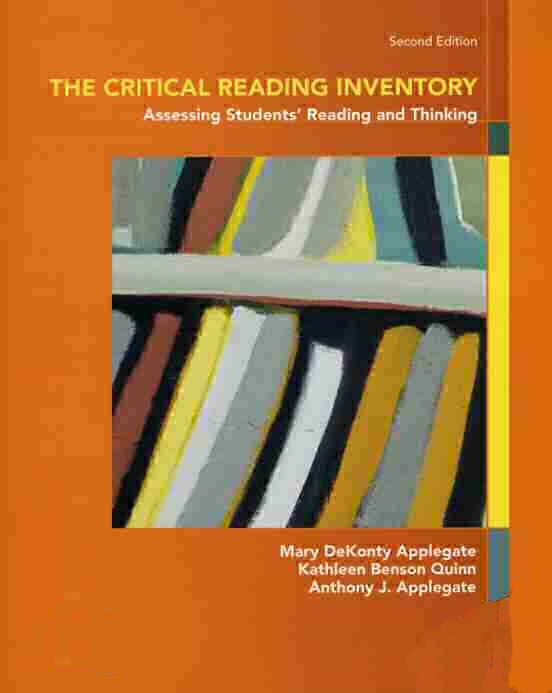Using the Critical Reading Inventory (CRI 3-E)
The
electronic edition of the Critical Reading Inventory (CRI 3-E) continues
the fundamentally different approach to the assessment of reading
comprehension exemplified in the original CRI. Classroom research and
assessment analyses suggest that many educators and assessment
specialists believe that comprehension involves the ability to
faithfully reproduce the ideas conveyed by a writer. We take the
position that comprehension also includes the ability to react
thoughtfully to ideas in text, to consider their significance, and to
use them as the basis for logical conclusions. To that end, nearly 60%
of the comprehension items you will find in the CRI require readers to
respond thoughtfully to the ideas they have encountered. As a
consequence, CRI users are able to distinguish readers who can simply
recall what they have read from readers who are also able to think about
it. This type of analysis also enable educators to target instruction
to meet the varying needs of their students.
Automated Scoring and Interpretation Interview (ASII)
Mindful of the demands on time that informal assessment can make of
teaching professionals, we set out to simplify the process as much as
possible. Our aim was to remove much of the time-consuming drudgery
associated with the scoring, calculating and reporting of the results of
an informal reading inventory. Our solution is the Automated Scoring
and Interpretation Interview (ASII). Users who have completed the
assessment and scoring of the CRI can access the ASII and click on
appropriate boxes to input the number of word list miscues, the oral
reading miscues, and the comprehension items for which the reader has
received full or partial credit. The ASII will automatically calculate
the percentage scores for the Word Lists, the RAI and MMI for each
passage read aloud, and the oral, silent and/or average comprehension
item scores at each level. The tool will further break down
comprehension performance to indicate Text-Based, Inferential and
Critical Response scores. The user of the ASII can also easily access
the Automated Retelling Scoring tool described above from within the
program.
At the
conclusion of the interview, the ASII will respond with a completed and
professionally formatted Recapitulation Record that can be printed and
used as part of a student’s academic records. The ASII will also
calculate and print a Level One Analysis Worksheet which juxtaposes key
information from the Recapitulation Record and facilitates the
interpretation of a child’s reading performance. In previous editions
of the CRI, users were restricted to a downloaded version of the ASII
that functioned only on Windows-based computers. CRI 3-E subscribers
will have access to a web-based version of the ASII which will work on
any device with Internet access.
Telephone Access
CRI 3-E subscribers will have access to a telephone hotline number which
will allow them to contact one of the authors or publishers of the CRI
3-E with technical or user-related questions. We welcome the
opportunity to gather feedback about the CRI 3-E and its strengths and
weaknesses, in anticipation of its continued development as a valuable
assessment tool.
Tutorials
Valuable class time can often be consumed by the task of teaching users
how to score student responses reliably and consistently. We would
certainly never argue that this kind of instruction is unimportant, but
it can expend a significant amount of class time that could be used for
more crucial issues such as interpretation of results and instructional
planning based on those results. We have attempted to address this
problem by developing detailed tutorials which provide users with
extensive practice in the scoring of miscues, retellings and
comprehension items. Each tutorial is divided into sections to allow
users to proceed at their own pace.
The Miscue
Tutorial will present the user with a record of a child’s oral reading
with miscues noted using the system as explained and illustrated in the
CRI II text. The user must interpret the miscue as either maintaining
or violating the meaning and syntax of language. Answers will be
submitted in a multiple choice format and the program will respond with
the correct response and explanatory feedback after each answer.
The
Retelling Tutorial will present users with a student retelling and ask
them to judge whether each of the text elements included in the
Retelling Rubric is present, partially present or absent in the
student’s retelling. It will then ask the user to calculate the
retelling score or submit the results to the Automated Retelling Scoring
tool. The program will respond with the correct answer and instructive
feedback after each user response.
The
Comprehension Item Scoring Tutorial will present the user with actual
student responses to CRI II items and ask them to score the response as
meriting Full, Partial or No Credit. The tutorial will include a sample
of responses to Text-Based, Inferential and Critical Response items at
three different grade levels, representative of the range of levels that
can be tested on the CRI II. Once again, the program will respond with
the correct answer and a detailed explanation of the scoring of each
item included in the tutorial.
All 3 Tutorials can be accessed through the CRI 3-E web site.
|
